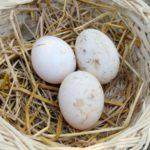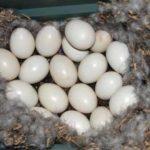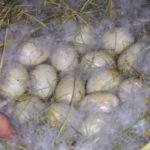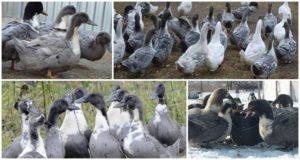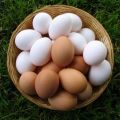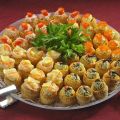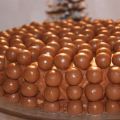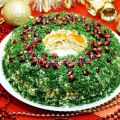Is it possible to eat and what do eggs look like, the benefits and harms of such food
Muscovy ducks, or Indo-ducks, are a type of large ducks that were domesticated by humans in the second half of the 19th century. Indo-ducks lay 8 to 14 eggs, which are of nutritional value. Eggs taste like chicken eggs; they can be prepared according to traditional recipes or used in home cosmetology. Indo-duck egg production rates are much higher than that of normal-sized chickens and domestic ducks.
Egg appearance
Outwardly, duck eggs look like large chicken eggs. But a closer inspection reveals numerous differences.
| Criterion | Description |
| Weight | Varies from 100 to 150 grams. |
| Colour | The yolk is colored with a rich yellow color, the white is whitish, translucent. |
| The form | The egg is elongated, pointed at the top. |
| Shell characteristics | The dense white shell is responsible for the strength of the shell. It is not possible to break the shell immediately. |
After the egg is broken, the yolk begins to flow out. In terms of density, it is more viscous than that of a chicken egg. A rich yellow color means increased carotene content. The protein is different in consistency. The mucous part is more dense and transparent.
Information! One duck egg is equal to two chicken eggs in weight and volume.
Benefit and harm
The usefulness of the product is due to its chemical composition.
Reference! If an allergy to chicken eggs is found, it is recommended to try the eggs of the Indoor, which may not give a reaction.
Cooking use
Indo-duck eggs are eaten in the same way as chicken eggs. To prepare a dish, the egg is recommended to be kept at room temperature for 30 minutes or slightly warmed up over the stove. This technique helps to break down the dense duck shells faster.
Before cooking, the surface is thoroughly washed with soap and a brush. Usually a fresh egg is covered with droppings.
It is customary to cook classic dishes from the product:
- omelet;
- scrambled eggs;
- yolk sauces;
- protein mousses;
- add to batter or dough;
- cook egg-based dishes for the first or second serving.
Indo-duck eggs are classified as exotic foods. For example, in the Philippines, they are eaten only when the embryo is formed inside. For this, several specimens are placed on the hen and taken out after a few days.

The Japanese prepare an exotic product using the canning method. Together with the shell, it is poured with a special syrup, used after infusion, when the shell softens.
Cosmetics
Homemade cosmetics are prepared using a raw product. There are several scenarios for use:
- Yolks and whites are suitable for preparing masks, they are applied to the face, then washed off with warm water.
- The yolk and olive oil face pack belongs to the group of nourishing home remedies. When compared to masks made from chicken or quail yolk, this product shows better results.
- To make the hair shiny, take the yolk and make a mask with the addition of auxiliary ingredients.
- Whipped whites are applied to the face skin prone to oily. The mechanism of action is based on the ability of the protein to tighten the skin and tighten pores.
- Beaten yolks are applied to the body, wrap is done. The procedure is responsible for activating regenerative processes. At the same time, an increase in blood flow occurs.
Product selection and storage
An exotic product is purchased from regular suppliers. Duck farms value their reputation and offer only fresh and quality products.
When storing, it is advised to adhere to the basic rules:
- eggs are stored in horizontal trays;
- periodically, each copy is turned 180 degrees to prevent the yolk from drying out;
- the temperature regime is set in the range from +8 to +15 degrees, a decrease or increase leads to a decrease in qualities;
- the maximum storage period for fresh product is 15 days.
You should not purchase products that are different in size, with cracks or notches on the shell. Various microorganisms linger on the shell. If damaged, they penetrate and lead to damage to the yolk or protein. Such specimens are not suitable for cooking.






